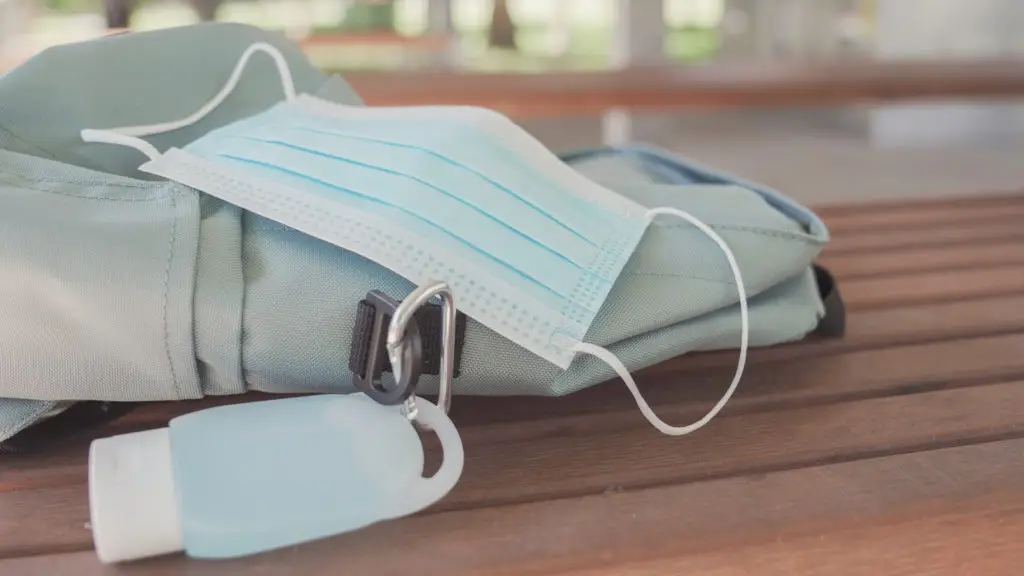The scramble to reopen schools, keep students safe, and keep them learning hasn’t abated in our analysis of 100 of the nation’s largest and highest-profile school systems.
This week, more districts are tightening health precautions and clarifying quarantine procedures. Online learning options continue to proliferate, but many new or expanding online schools won’t be set up to allow students in quarantine to continue learning.
States and districts ramping up masks and vaccines
All 100 districts in our review have now set a mask policy. Three in four (75) require masks for all students, and five more require masks for at least some students. Only a fifth (20) keep masks optional.
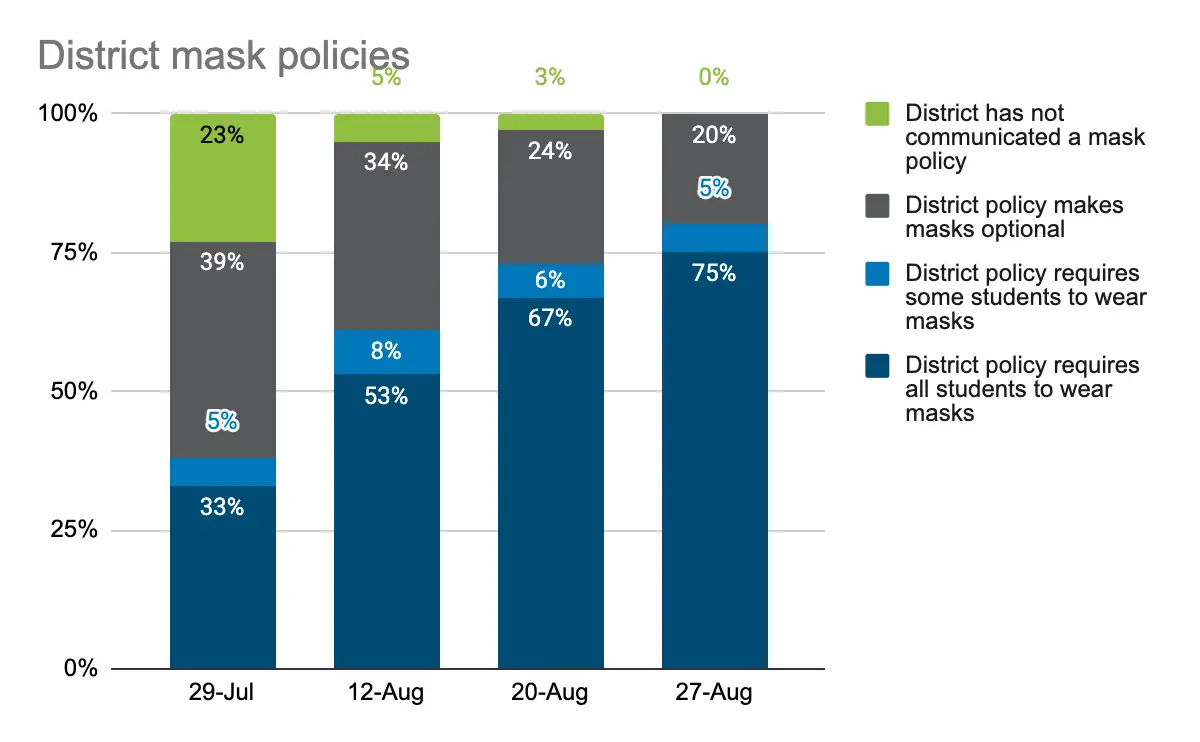
Vaccine requirements also continued to spread at both the state and district level. New Jersey became the first state on the East Coast to require teacher vaccines, and hours after getting sworn in, New York Governor Kathy Hochul announced her intention to follow suit.
A total of fifteen districts in our analysis now require vaccinations for school staff, an increase of five from last week. Nine require staff members to either get vaccinated or participate in weekly testing. Six require all staff to get vaccinated, without a testing alternative: Chicago Public Schools, Denver Public Schools, L.A. Unified School District, New York City, Portland Public Schools in Oregon, and Seattle Public Schools).
New York City schools announced a universal vaccine mandate shortly after the FDA approved Pfizer’s vaccine.
The regulatory approval could provide political cover for more efforts to require, or at least encourage, vaccinations. Governors Asa Hutchinson (AR) and Phil Murphy (NJ) issued a bipartisan statement applauding the vaccine’s approval and encouraging COVID-19 vaccinations for those who are hesitant.
Districts exempt more students from quarantine
More than four in five districts in our analysis (85) have now updated their plans for keeping some students out of school if they are exposed to COVID-19.
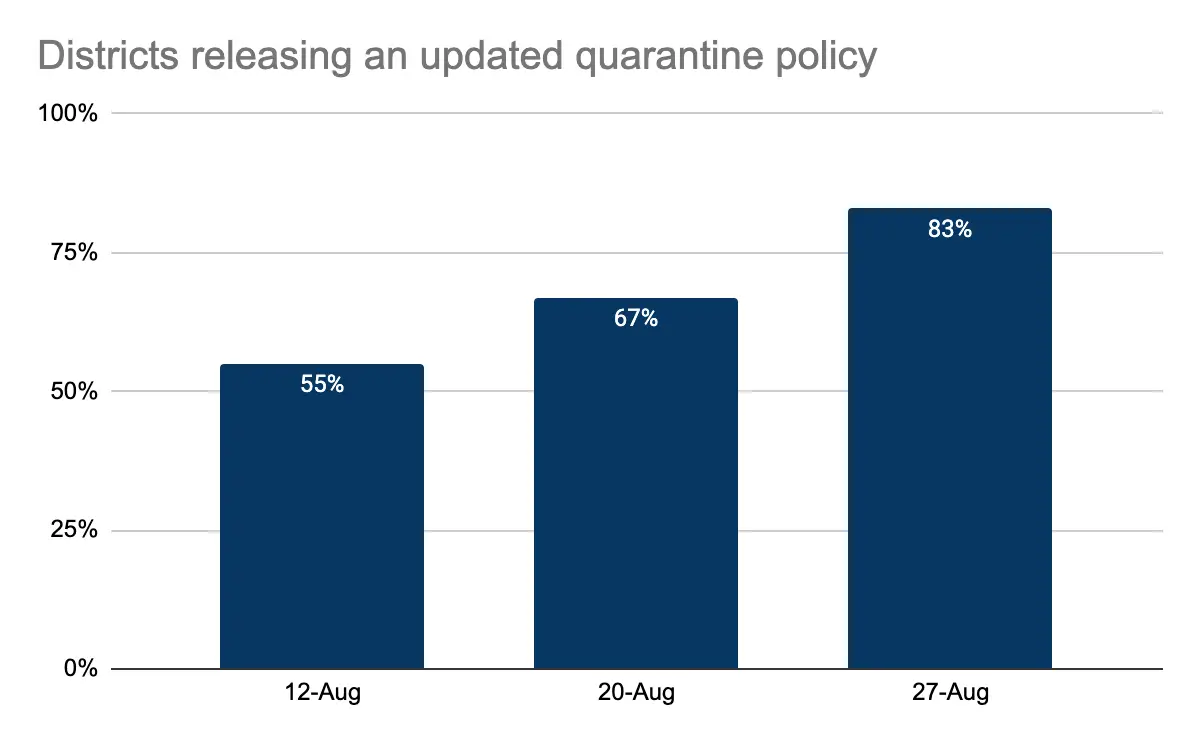
Some communities are being ravaged by quarantines and closures. Mississippi has now quarantined 15 percent of its students. In Georgia, twenty districts have already put in-person learning on hold. As quarantines interrupt back-to-school for thousands of students across the country, districts are beginning to set more nuanced policies that exempt some students from quarantine entirely, or allow them to return to school early with a negative COVID test.
Of the districts in our review, the majority (58 of 83, or 70 percent of districts with policies) will exempt vaccinated students from quarantines. A sizable portion are exempting students who have recently recovered from COVID (25, or 30 percent) or students wearing masks (18, or 20 percent).
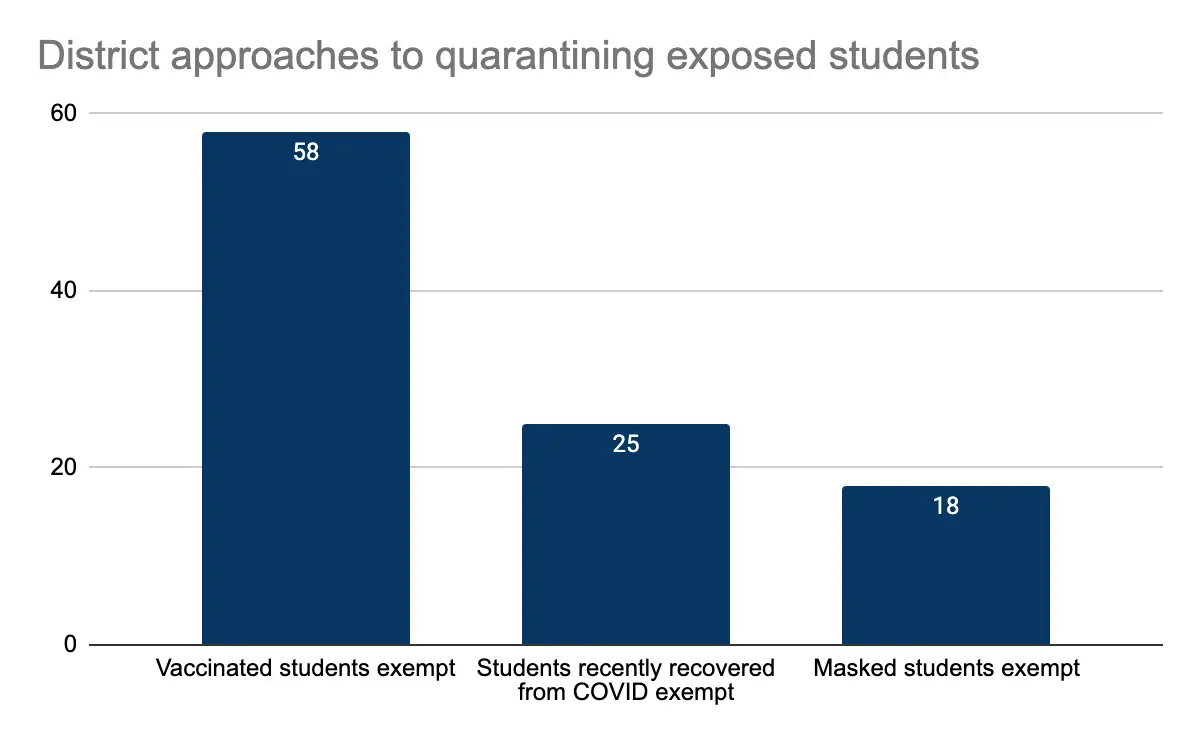
Meanwhile, 22 districts report they will shorten the quarantine period for students who receive a negative COVID-19 rapid antigen test. The majority of these set a time frame for testing and return to school, ranging from two to seven days after exposure.
While it allows many exemptions, Alaska’s Anchorage School District continues to share the longest potential quarantine period, allowing up to 24 quarantine days for students who live with an infected household member and cannot avoid continued close contact.
On the other extreme, Wichita Public Schools (KS) will allow exposed students to return to school immediately, provided they wear a mask for fourteen days and take daily rapid antigen tests for eight days. Two weeks into school opening, however, Wichita has already placed 1,600 students (roughly 3 percent of students) in quarantine for COVID exposure.
A growing number of districts are also setting procedures to shut down entire classrooms if COVID exposures become widespread. Florida’s Duval County Public Schools recently updated its policy so that elementary classes will transition to online learning if two or more cases arise in a seven-day period.
Districts still short on details about keeping quarantined students learning
A little more than a third of districts in our review (38) describe plans to support learning for students required to quarantine. Half of these (19) make a general statement of commitment to provide students remote learning but give no further detail.
The other 19 give some detail on what to expect: 17 share that they will send students home with work, 11 plan to provide access to assignments through an online platform such as Schoology, and 6 plan to provide take-home assignments or packets. The remaining 2 provide a combination of take-home and remote assignments.
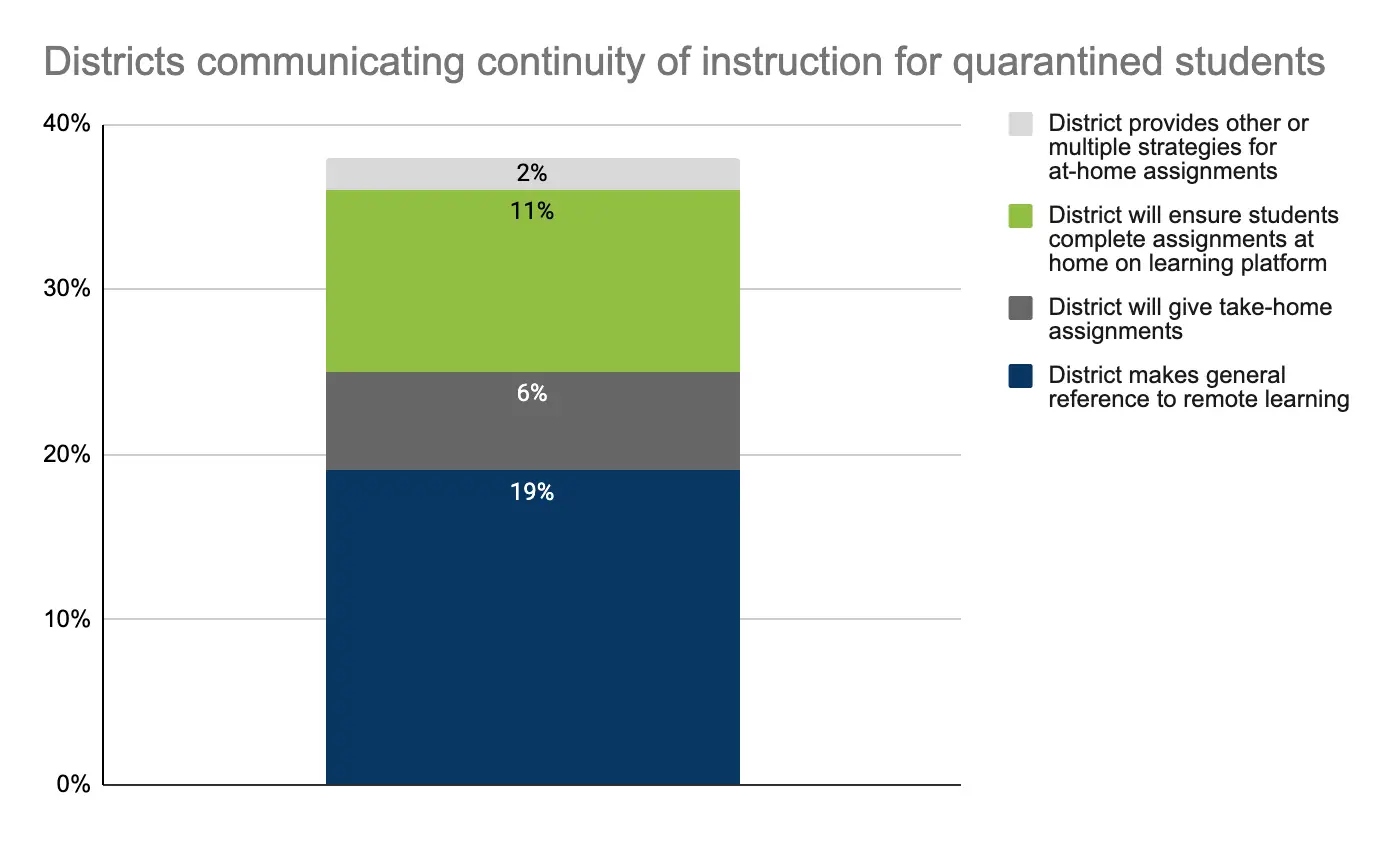
Of the 38 districts referencing continuity of instruction for quarantined students, 16 plan to provide instruction or support.
Houston ISD provides the most information of any district we reviewed, with a dedicated webpage for quarantined students to learn about their options. The district commits to four hours of real-time instruction a day, for up to twenty days total this school year—the maximum number allowed under new Texas funding rules. Students can also access the district’s remote learning platform. This level of clarity could serve as a model for other districts.
Three other districts commit to providing real-time instruction to students in quarantine: Clark County (NV), Jackson Public Schools (MS), and Jefferson County (KY). Another six commit to providing students access to check-ins with teachers and staff.
It is not clear that districts will make their full-time remote learning programs available to quarantined students. Just one district so far, Los Angeles USD, clarifies this: they do not.
Remote Learning
More than 9 in 10 districts in our review (92) are offering online learning opportunities. However, a little more than half of these (56) are open to all students. While many districts do not provide information on learning program capacity, 17 report enrollment caps.
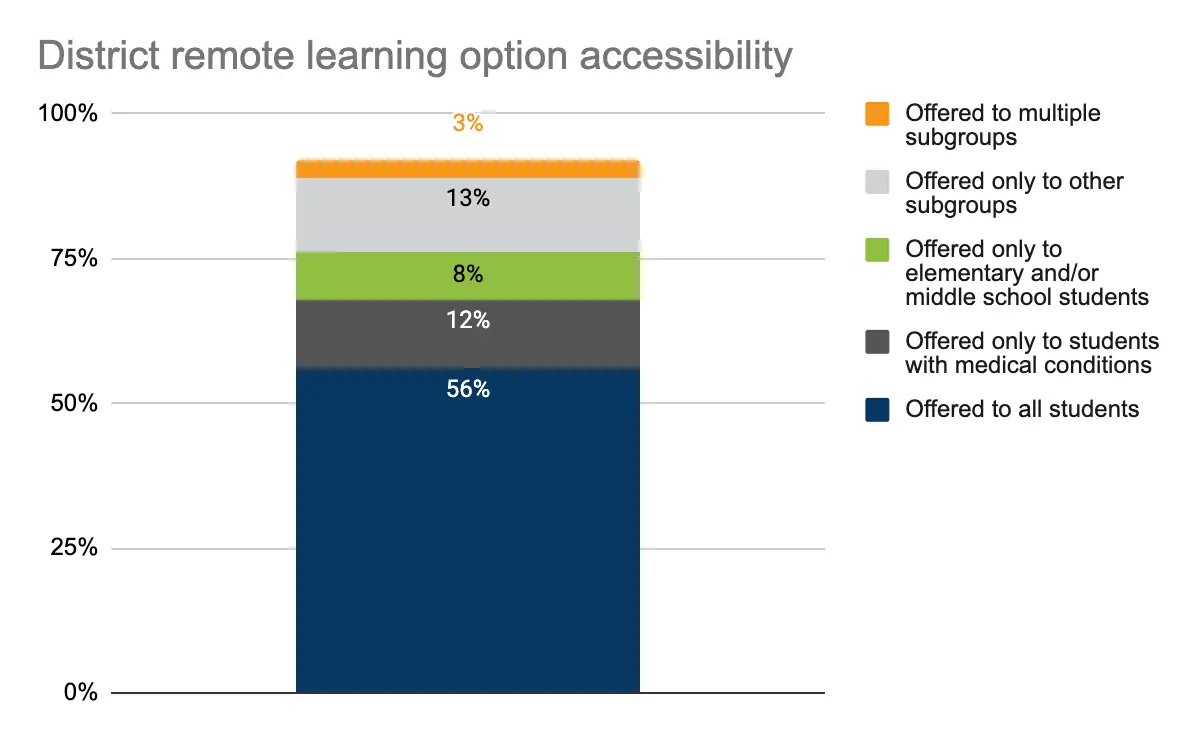
Three school districts in Texas—Arlington, Dallas, and Houston ISDs—recently opened virtual learning for grade levels not yet eligible for the COVID vaccine.
Houston, like Austin ISD, is using federal stimulus funding to offer this option since the state does not fund full-time remote students.
Dallas announced its new virtual school to families on August 19th, received 1,600 applications by its August 23rd 10:00 a.m. deadline, and started school the next morning. Five hundred of these students had not yet reported to school but were willing to enroll in the virtual option. The district commits to re-evaluate the need for its virtual option each nine weeks—in part because state funding for the effort remains uncertain.
Prepare for a turbulent return to school
Dallas’s rapid rollout of virtual learning foretells debates set to erupt in other parts of the country.
Parents may feel that their local schools’ testing, vaccination, or masking policies are inadequate—or protest that they are excessive. Those parents then face a choice: Give up their spot in their school to enroll in a virtual school, or send their kid to a campus where they don’t feel comfortable. (Some may choose to leave the public school system entirely.)
If district-run remote learning remains limited, or ineligible for state funding, districts might also lack a ready means to keep students learning through periods of quarantine or isolation.
In some districts, parent fears and desire for more flexible remote options are already exploding into school board meetings, and that, in turn, could lead to pressure on state leaders to authorize remote learning.
But remote learning can also come with a cost—especially if it’s hastily assembled in a matter of days or weeks before school starts. The longer schools were closed over the past 18 months, the greater the harm to students’ academic progress and emotional well-being.
We will continue tracking how state and district leaders navigate these dilemmas in the weeks to come, but one thing is clear: They should brace for turbulence ahead.



